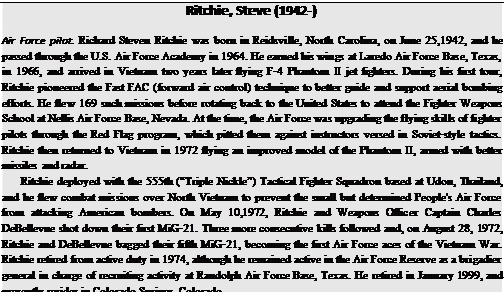1972
JANUARY 5 In Washington, D. C., President Richard M. Nixon declares that $5.5 billion has been budgeted for the new space shuttle program.
FEBRUARY 17 At Andrews Air Force Base, Maryland, a VC-137 Stratoliner from the 89th Military Airlift Wing conveys President Richard M. Nixon on his historic mission to Beijing, China.
February 20 In Illinois, an HC-130H Hercules sets a new world record by flying in from Taiwan during a nonstop, unrefueled flight.
MARCH 30 In Washington, D. C., the Joint Chiefs of Staff (JCS) authorizes 1,800 B-52 sorties throughout Southeast Asia. This total is up 600 sorties from a previous directive issued on February 8.
The massive Communist “Easter Offensive” erupts across South Vietnam as 40,000 North Vietnamese troops, backed by 400 tanks, attacks through the Central Highlands. They are largely halted by Air Force and Navy aircraft.
April 6 In light of the Communist offensive in South Vietnam, Air Force and Navy aircraft resume their bombardment of North Vietnam for the first time since 1968.
April 7 In South Vietnam, General John W. Vogt, Jr., gains appointment as head of the Seventh Air Force.
April 7—May 13 In South Vietnam, Operation constant guard unfolds as 200 Air Force aircraft, stationed stateside, arrive to help contain the Communist Easter Offensive.
April 16—27 Apollo 16 becomes the fifth successful lunar expedition as Air Force astronaut Charles Duke, Jr., and Navy astronaut John Young remain a record 71 hours on the moon’s surface.
April 27 Over North Vietnam, Air Force warplanes use 2,000-pound laser – guided Paveway I “smart bombs” against the Thanh Hoa Bridge, dropping several spans. Previously, 850 conventional attacks failed to seriously damage this structure.
MAY 5 The new Pave PAWS system becomes operational, being specifically design to detect incoming, sea-launched ballistic missiles.
MAY 10-October 23 The Fairchild YA-10 prototype, conceived as a heavily armed and armored close support aircraft, flies for the first time; in January 1973 it enters production as the A-10 Thunderbolt II.
Over North Vietnam, Operation freedom train commences as the Air Force resumes full-scale aerial attacks against military and economic targets. Early on, the name is changed to Operation linebacker i. At one point in the campaign, F-4 Phantoms from the 8th Tactical Fighter Wing knock out Hanoi’s Paul Doumer Bridge with precision-guided bombs.
May 13 Over North Vietnam, 14 F-4 Phantoms drop laser-guided and conventional ordnance against the Thanh Hoa Bridge, dropping several spans and rendering it useless for rail traffic for several months.
JUNE 11 Over Hanoi, North Vietnam, laser-guided bombs dropped by B-52s destroy a major hydroelectric plant.
JUNE 29 In Quang Tri Province, an A-10 Bronco piloted by Captain Steve L. Bennett, 20th Tactical Air Support Squadron, attacks enemy units preparing to ambush friendly forces, despite the fact that no other air support is available. After his plane is shot, Bennett orders his observer to bail out, but he dies in an attempt to ditch in some nearby water; he receives a posthumous Congressional Medal of Honor.
July 26 Rockwell International is declared to be the prime contractor to build a fleet of space shuttles for NASA.
July 27 The McDonnell Douglas YF – 15A air superiority fighter performs its maiden flight; it enters production as the F-15 Eagle.
August 11 The Northrop F-5E Tiger II prototype is flown for the first time; this is
a single-seat, armed version of the T-38 Talon trainer.
August 28 Over North Vietnam, Captains Richard S. Ritchie and Charles DeBellevue shoots down their fifth MiG-21, becoming the first Air Force aces of this war.
SEPTEMBER 9 Over North Vietnam, weapons systems operator Captain Charles DeBellevue downs his sixth MiG-21, becoming the highest-scoring ace of the war.
SEPTEMBER 11 Over North Vietnam, Air Force fighter-bombers drop precision – guided weapons on the Long Bien Bridge in Hanoi, destroying it.
 |
OCTOBER 2 At Vandenberg Air Force Base, California, an Atlas-Burner launch rocket carries two satellites aloft: Space Test Program 72-1, to measure radiation effects in space, and Radcat, a passive radar and optical calibration target.
OCTOBER 13 Over North Vietnam, weapons officer Captain Jeffrey S. Fein – stein shoots down his fifth MiG, becoming the final Air Force ace of the war. Feinstein, Richard S. Ritchie, and Charles B. DeBellevue all win the Mackay Trophy.
NOVEMBER 22 Over North Vietnam, a B-52 is damaged by a Communist SA- 2 missile and the crew manages to eject over Thailand; this is the first heavy bomber lost.
December 1 Colonel and astronaut Thomas P. Stafford is promoted to brigadier general in the Air Force, aged 42 years.
DECEMBER 18—29 Over North Vietnam, Operation linebacker II kicks into effect in order to bring North Vietnam back to the Paris peace talks. All told, 741 B-52 sorties are flown, along with 796 flak suppression missions; 15 B-52s are downed, along with 2 F – 111s, 3 F-4s, 2 A-7s, 2 A-6s (Navy), 1 EB-66, 1 HH-53, and 1 RA-5C (Navy). On the first day of the attack, B-52 gunner Sergeant Samuel O. Turner downs a MiG-21 as it tries to attack.
DECEMBER 24 Over North Vietnam, B – 52 gunner Airman First Class Albert E. Moore shoots down the second MiG-21 scored in this fashion.










